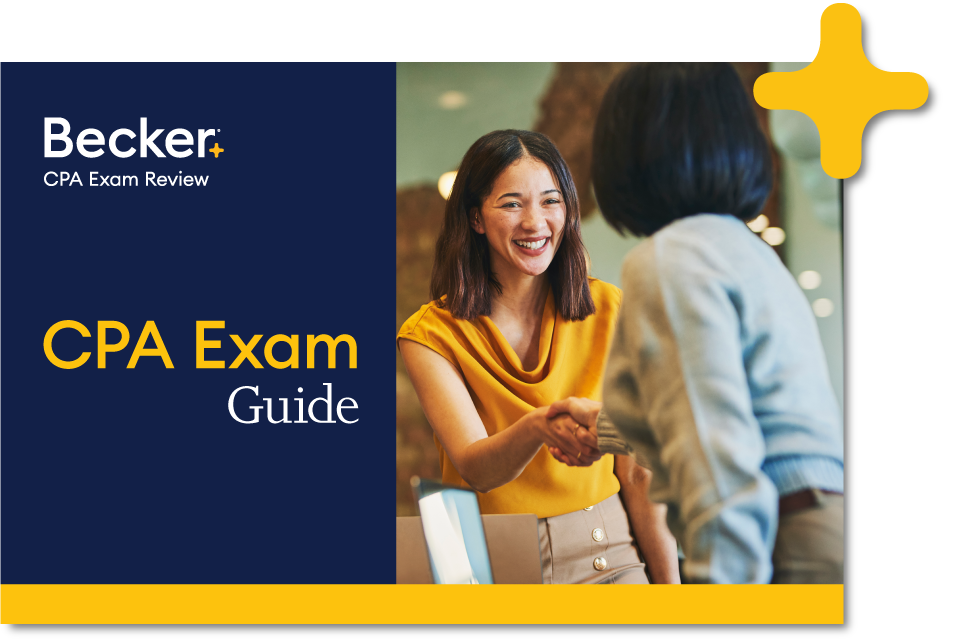Starting in January 2024, students aspiring to earn their CPA license piloted a new exam structure, called CPA Evolution. Designed to fill in knowledge gaps and prepare new CPAs for necessary skills, the CPA Exam is now composed of 3 Core Exam sections and 1 Discipline Exam. The Business Analysis and Reporting (BAR) is one of the three new Discipline sections. To help you prepare and pass, we’re examining the overall structure of this new section, as well as tips to get Exam Day ReadySM.
Read on to remove the mystery surrounding the exam’s content and structure, unlock tips on how to prepare and determine if this Discipline is right for you. Your career is waiting; it’s time to raise the BAR!
Table of contents
- What is the BAR CPA Exam?
- BAR vs FAR
- Composition of the BAR CPA Exam
- What is tested on the BAR CPA Exam?
- BAR CPA study tips
- Is the BAR Discipline right for me?
- BAR CPA Exam FAQs
Download our FREE 2024 CPA Exam Guide

What is the BAR CPA Exam?
The CPA Exam is a rigorous exam, consisting of four separate tests to assess a CPA candidate’s knowledge and skill level in more complex accounting topics. Passing all four sections of the CPA Exam is necessary for candidates to earn the prestigious Certified Public Accountant (CPA) license.
In January 2024, the American Institute of Certified Public Accountants (AICPA) and the National Association of State Boards of Accountancy (NASBA) launched a substantial reorganization of the CPA Exam. It is now composed of four sections: three required Core sections that all candidates must pass, plus one Discipline section that builds upon the fundamentals of the Core Exams and tests a more profound understanding and application of concepts.
While all candidates must pass the three Core Exams, they only choose from one of three different Discipline topics; BAR is one of these three options.
CPA Exam | |||||
Core exam sectionsAll three are required | Discipline exam sectionsCandidates choose one | ||||
AUD | FAR | REG | BAR | ISC | TCP |
Auditing & Attestation | Financial Accounting & Reporting | Taxation & Regulation | Business Analysis & Reporting | Information Systems & Controls | Tax Compliance & Planning |
The Business Analysis and Reporting (BAR) section of the CPA Exam tests candidates’ financial analysis and risk management and planning skills, with an additional focus on data and technology used in decision-making.
BAR vs FAR
As part of the newly organized CPA Exam structure, the AICPA created the BAR CPA Exam as an extension of FAR, testing advanced skills and concepts that are assessed in their fundamental form during FAR. For those aiming to specialize in financial analysis, technical accounting and applied research, BAR offers the opportunity to demonstrate this expertise and advance a career that leverages these skillsets.
For example, while FAR may pose a question about basic revenue recognition as it relates to the five-step process, BAR requires candidates to interpret and analyze agreements, contracts and other supporting documentation to apply the revenue recognition concepts. Likewise, FAR only tests leases from the lessee’s perspective, while the BAR focuses on the lessor’s perspective which can be more complex.
Many topics previously included on the FAR exam have been shifted to the BAR. These include:
- Advanced government accounting
- Lessor accounting
- Derivatives and hedge accounting
- Employee benefits plans
- Indefinite lived intangible assets
- Public company reporting
- S-X and S-K reporting requirements
- Internally developed software
- Revenue recognition analysis
- Stock compensation
- R & D costs
- Business combinations
- Advanced consolidated financial statements
Composition of the BAR CPA Exam
During the BAR exam, candidates have four hours to complete fifty multiple choice questions (MCQs) and seven task-based simulations (TBSs), split up among three content areas:
- Business Analysis (40-50 percent)
- Technical Accounting and Reporting (35-45 percent)
- State and Local Governments (10-20 percent)
The MCQs and TBSs are broken down across five "testlets," so the format when you sit for the exam looks like to this:
- Pre-exam: Complete the welcome screen to confirm your information and add your "launch" code then your confidentiality code. You'll have five minutes for each screen.
- Testlet 1: 25 MCQs
- Testlet 2: 25 MCQs
- Testlet 3: Two TBSs
- 15-minute break that does not count toward your exam time
- Testlet 4: Three TBSs
- Testlet 5: 2 TBSs
Skill levels
All MCQs and TBSs on the BAR CPA Exam will fall under one of three "skill levels."
- Remembering and understanding refers to recalling specifics and understanding what is being communicated and how to use it effectively.
- Application refers to applying knowledge or concepts on the exam to practical scenarios
- Analysis refers to examining and studying how the separate areas relate to identify causes and find evidence to support inferences.
| Skill level | Weight |
| Remembering and understanding | 10 - 20% |
| Application | 45 - 55% |
| Analysis | 30 - 40% |
How is BAR scored?
The BAR CPA Exam is graded on a scale from 0 to 99 and you must score a 75 or above to pass. The 50 MCQs make up 50 percent of the weighted score, and TBSs make up the other 50 percent.
While the AICPA does not grade on a curve, they do weigh the questions on difficulty, so harder questions count for more than easier questions. Also, you can earn partial credit on TBSs because you must answer multiple questions in each scenario. Once your exam is graded and the weights are applied, your score is aggregated on the 0 to 99 scale.
What is tested on the BAR CPA Exam?
BAR includes financial statement analysis, technical accounting and reporting and local, state and government accounting and reporting. The AICPA also provides this highly detailed breakdown of topics that may be tested in each content area of the exam:
Content Area I: Business Analysis | Content Area II: Technical Accounting and Reporting | Content Area III State and Local Governments |
|
|
|
BAR CPA study tips
The CPA Exam as a whole, including BAR is notoriously demanding and even difficult to pass. But don’t let this reputation dissuade you; there is encouraging news for aspiring candidates! The right study habits help students prepare for the exam and exponentially boost percentages of passing rates for first-time test takers.
Becker's CPA Exam Review offers a comprehensive set of study and practice materials to help you feel ready to tackle BAR with confidence:
- Digital flashcards with relevant concepts and vocabulary
- Video instruction to explain specific topics covered on the exam
- MCQs and TBS practice questions
- Unlimited practice tests that are personalized for each candidate
- Exam simulations that mirror the actual CPA Exam in length, format, and style
- Livestreaming courses from expert CPAs instructors
An exam prep course from a trusted partner like Becker can help you combine these study materials in a single, convenient platform—making it easy to unlock a curated database of relevant exam material and resources. Plus, a structured course provides a mapped-out journey to exam preparation that also serves to keep you accountable in your study process.
Is the BAR Discipline right for me?
Need help choosing a Discipline? National Instructor Mike Potenza shares the three questions to ask yourself to help you make the right choice!
Choosing your CPA Exam Discipline is an important decision that can steer your career's development and job opportunities while setting the foundation for future accreditations and specialization.
The BAR Discipline may be right for you if you enjoy analytics and reporting, studying and applying regulations and dissecting financial documents to determine facts and inform decisions.
Take our 4-question quiz to find which Discipline is right for you!
BAR CPA Exam FAQs
How is BAR scored?
All sections, including BAR, are sored on a scale from 0 to 99, and candidates must earn a 75 or above to pass. The MCQs and TBSs are weighed evenly, each at 50 percent of the student's score.
What is the BAR pass rate?
In 2024, the overall BAR CPA pass rate was just 38%, showing that it's one of the most difficult sections. However, for Becker Exam Day ReadySM students, this pass rate was 64%--proving that, with the right preparation, you can most definitely pass the first time.
When should I take the BAR?
If you have decided on BAR as your Discipline Exam, you're closer to deciding the best order to take the CPA Exam.
We typically recommend taking the FAR CPA Exam first if you have a strong GAAP and accounting foundation, as this contains fundamental information in financial accounting which will help you on your other exams. However, FAR is also considered one of the more difficult sections, so you may instead opt to take other sections first to build your confidence, motivation, and study habits.
If you choose BAR, Becker recommends one of these orders, depending on your priorities:
- FAR
- BAR
- AUD
- REG
OR
- REG
- AUD
- FAR
- BAR
Can I finish the BAR exam in just 4 hours?
While you shouldn’t rush, do maintain an efficient pace to complete the entirety of the exam within the allotted 4-hour limit. This certainly is achievable! A reasonable plan is to spend about 1.8 minutes per multiple choice question, completing all 50 MCQs in about 90 minutes. At roughly 20 minutes per task-based simulation, you’ll then spend 140 minutes on TBSs and have the final 10 minutes available for a final review of your work.
Try Becker's CPA Exam Review FREE for 14 days
If you're ready to study for BAR or any other section of the CPA Exam, Becker has the academic support, resources and materials you need to pass on the first time. Get a 14-day free trial and find out why more people trust Becker to help them get Exam Day Readysm!








